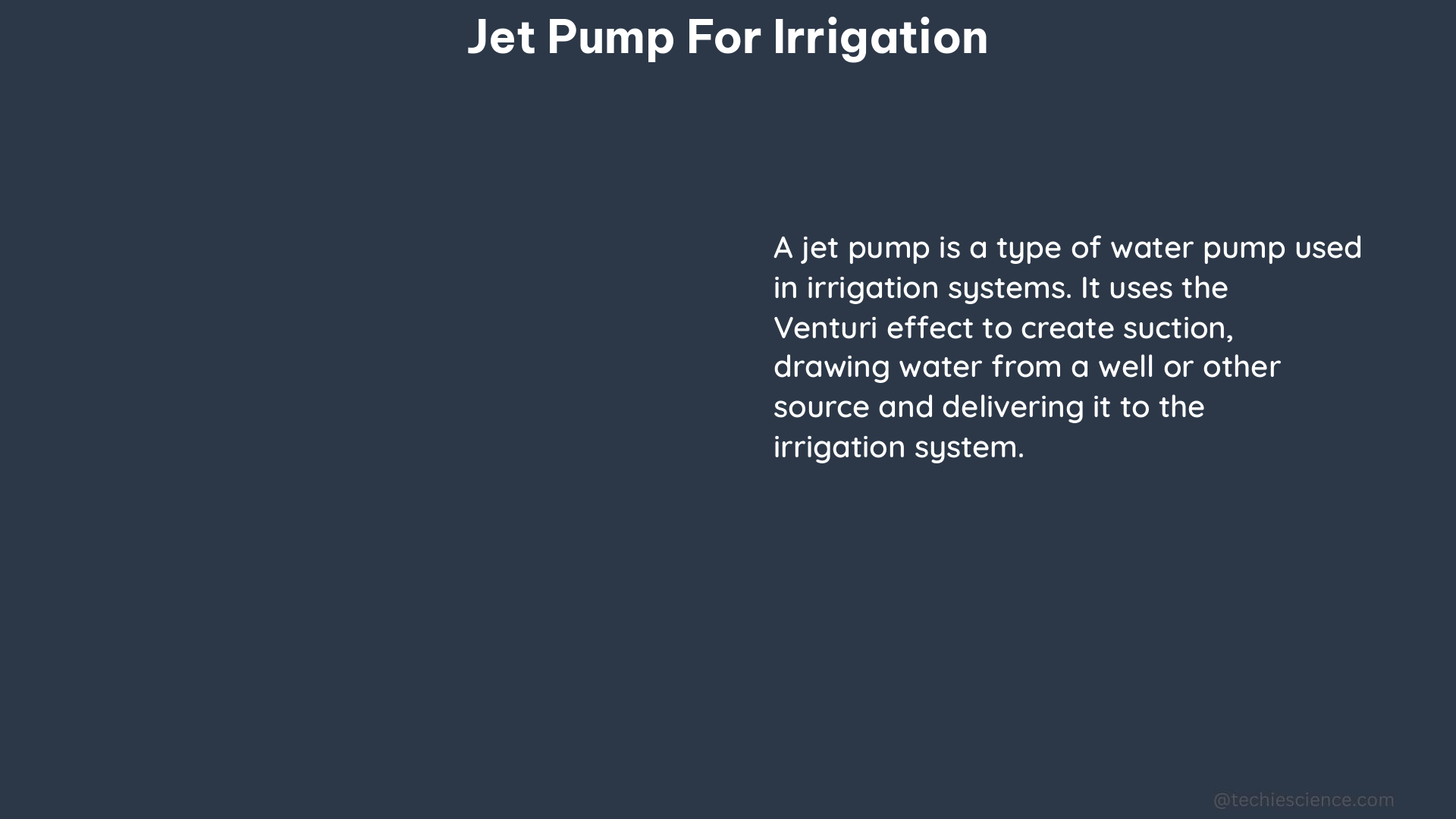Jet pumps are a popular choice for irrigation systems, particularly in deep well applications, as they utilize the principle of jet propulsion to draw water from a depth. When selecting a jet pump for your irrigation system, it is crucial to consider the specific requirements and characteristics of your setup to ensure optimal performance and efficiency.
Understanding Jet Pump Principles
Jet pumps work by using a high-velocity jet of water to create a low-pressure area, which in turn draws water from the well or other water source. This process is known as the Venturi effect, and it allows jet pumps to lift water from depths of up to 25 feet (7.6 meters) or more.
The key components of a jet pump include:
- Impeller: The impeller is responsible for generating the high-velocity jet of water that creates the suction.
- Nozzle: The nozzle is designed to accelerate the water flow, creating the high-velocity jet.
- Venturi tube: The Venturi tube is a constricted section of the pump that creates the low-pressure area, allowing the water to be drawn in.
Selecting the Right Jet Pump for Your Irrigation System

When choosing a jet pump for your irrigation system, there are several factors to consider:
1. System Requirements
- Flow Rate: Determine the required flow rate (in gallons per minute or liters per second) for your irrigation system, taking into account the number and type of watering devices, such as sprinklers or drip emitters.
- Pressure: Calculate the required pressure (in pounds per square inch or kilopascals) at the pump to ensure proper operation of your irrigation system.
- Elevation Changes: Account for any changes in elevation between the water source and the irrigation system, as this will affect the total dynamic head (TDH) the pump must overcome.
2. Friction Loss Calculations
Friction loss is a crucial factor in determining the appropriate jet pump for your irrigation system. Use friction loss charts or online tools to calculate the pressure drop due to friction in the mainline, considering factors such as:
– Pipe material and size
– Pipe length
– Flow rate
Remember, a common misconception is that a smaller pipe size will increase pressure. In reality, pushing water through a smaller pipe faster to maintain outflow increases pressure loss.
3. Pump Capacity Measurements
To accurately size your jet pump, you’ll need to measure both the discharge rate and pressure under normal operating conditions. Use a flow rate meter to measure the discharge rate in gallons per minute (gpm) or liters per second (lps), and a pressure gauge to measure the pressure in pounds per square inch (psi) or kilopascals (kPa).
For example, if your sprinkler irrigation system requires 35 psi (214 kPa) at the pump, the maximum flow rate available from the pump is 13.0 gpm (0.82 lps). If the system requires more than 13.0 gpm, it will need to be designed and operated in zones to ensure no single zone exceeds this flow rate.
4. Factors Affecting Pump Performance
Several factors can influence the head-discharge curve of a jet pump, including:
– Pump design and size
– Power unit size
– Wear on impellers or other components
– Pump operating speed
– Well size and aquifer characteristics
– Depth to water table or surface water level
– Suction and discharge pipe size
Maintaining the intake screens and check valves is also crucial for preserving pump capacity.
Preventative Maintenance for Jet Pumps
To ensure the efficient and reliable operation of your irrigation system, it is essential to perform regular preventative maintenance on the jet pump, both in the pump station and the water well. This includes:
- Diagnostic Testing: Conduct periodic pump tests to assess the overall health of the pump and motor, allowing you to forecast repair timelines and budget for replacements.
- Inspection and Cleaning: Regularly inspect and clean the pump, motor, and associated components to prevent issues such as clogging or wear.
- Impeller Replacement: Replace the impeller as recommended by the manufacturer to maintain optimal pump performance.
- Well Maintenance: Maintain the well, including the intake screens and check valves, to prevent issues that could affect pump capacity.
By following these best practices for jet pump selection and maintenance, you can ensure your irrigation system operates at peak efficiency, delivering the required pressure and flow rate to your crops or landscaping.
References
- Jet Pump with Jet Assembly in the Well for Deep Well Applications
- Irrigation Pumps
- Question on Jet Pumps and Irrigation System Capacity
- Irrigation Pump Selection and Maintenance
- Improve Irrigation System Performance with Proper Pump Maintenance

The lambdageeks.com Core SME Team is a group of experienced subject matter experts from diverse scientific and technical fields including Physics, Chemistry, Technology,Electronics & Electrical Engineering, Automotive, Mechanical Engineering. Our team collaborates to create high-quality, well-researched articles on a wide range of science and technology topics for the lambdageeks.com website.
All Our Senior SME are having more than 7 Years of experience in the respective fields . They are either Working Industry Professionals or assocaited With different Universities. Refer Our Authors Page to get to know About our Core SMEs.